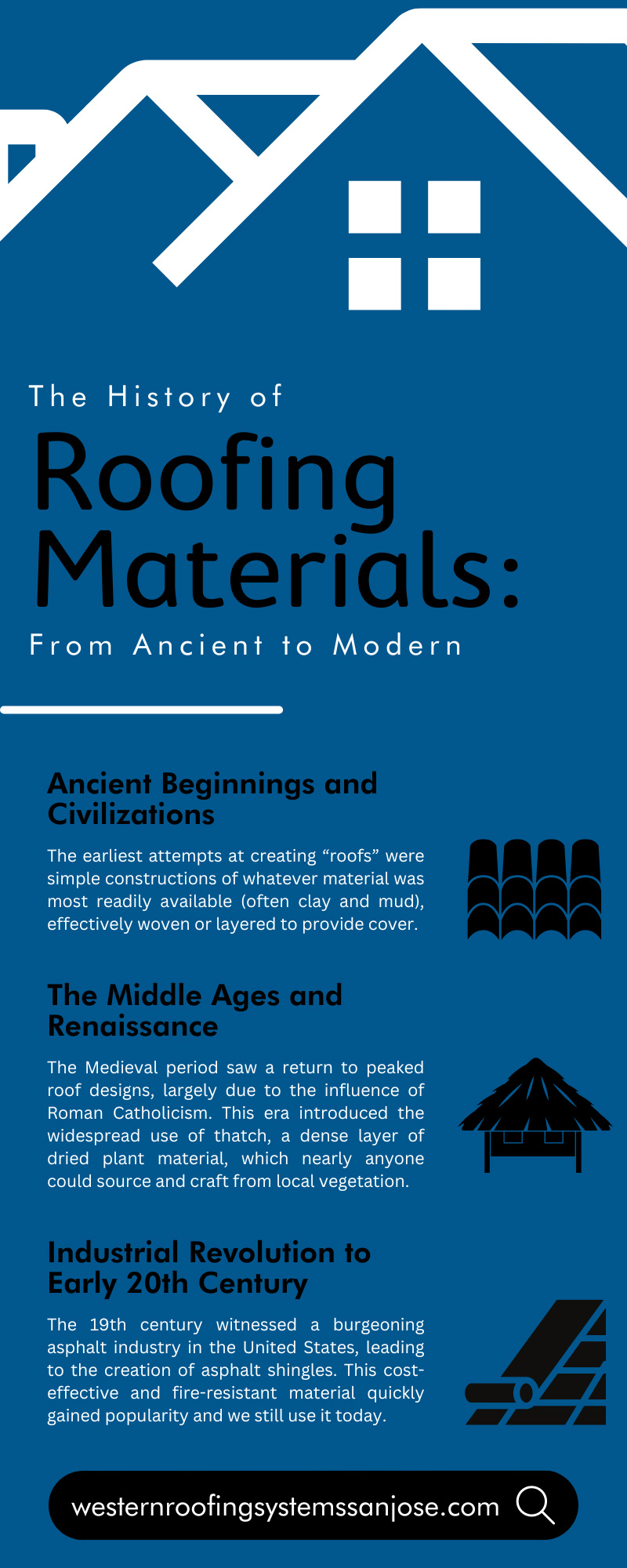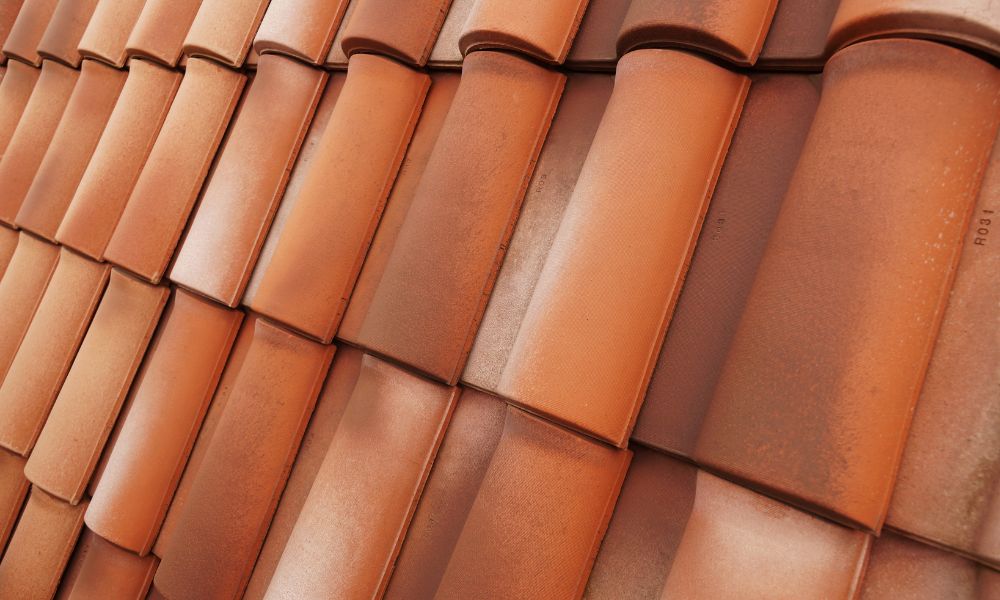As homeowners, we often take our roofs for granted, simply viewing them as a functional necessity to protect our homes. However, have you ever stopped to consider the history of roofing materials? Practical needs and cultural influences have shaped the evolution of roofing, from ancient civilizations using natural materials like thatch and clay to modern innovations such as metal and synthetic shingles.
Delve into the history of roofing materials—from ancient beginnings to modern times—and gain a newfound appreciation for this crucial aspect of our homes. Take a journey through time as we explore how roofs have evolved over centuries.
Ancient Beginnings and Civilizations
The history of roofing materials, from ancient to modern, is a tale that begins with the need for protection against the elements. The earliest attempts at creating “roofs” were simple constructions of whatever material was most readily available (often clay and mud), effectively woven or layered to provide cover. Mesopotamian structures, with their flat roofs, were the first to exemplify this practical approach to shelter.
The Ancient Egyptians took the technique a step further by combining straw and clay to make a thicker, more durable roof material. This denser material provided a stronger barrier between living spaces and Egypt’s sporadic rainfall. These techniques reverberated across many early civilizations, with each adding its unique materials and methods to roofing construction, including the Romans’ mastery of roof pitch and the Chinese’s ceramic tiling.
The Middle Ages and Renaissance
The Medieval period saw a return to peaked roof designs, largely due to the influence of Roman Catholicism. This era introduced the widespread use of thatch, a dense layer of dried plant material, which nearly anyone could source and craft from local vegetation. Thatched roofs had excellent insulating properties, and their availability and versatility made them a staple for centuries, gracing the European cottages and manors of peasants and lords respectively.
The Renaissance, however, saw a significant shift in design and material. The meticulously crafted slate and terracotta tiles became popular once again, especially throughout Italy, as they brought a sense of the classical world back into architectural fashion. This period marked the beginning of more intricate roofing designs, particularly of the curved shapes that became so beloved and iconic.
Industrial Revolution to Early 20th Century
The Industrial Revolution brought about a sea change in the roofing industry, as humans mechanized manufacturing processes and new materials became more readily available. Machine-cut shingles and tiles began to replace handcrafted ones, making roofing materials more accessible to a range of homeowners. The increased industrialization also saw the rise of metal roofing, initially a solution for commercial and industrial structures, due to its durability and fire resistance over thatch roofing.
The 19th century witnessed a burgeoning asphalt industry in the United States, leading to the creation of asphalt shingles. This cost-effective and fire-resistant material quickly gained popularity and we still use it today. The period also marked the emergence of cement-based roofing materials, which offered a similar fire resistance to that of asphalt but with greater durability and a traditional, handcrafted aesthetic.
Mid-20th Century
The mid-20th century was a time of cementing modern roofing materials into the mainstream. The use of fiberglass and other synthetic materials revolutionized the industry, making roofs lighter, stronger, and less prone to weathering. The desire for quick and efficient construction also gave rise to prefabricated roofing solutions, leading to a more standardized approach to the design and installation of roofs.
This era also saw the wider adoption of green and sustainable roofing practices, with a renewed appreciation for the ecological benefits of natural materials like cedar shingles and clay tiles. As concerns about environmental impact grew, so did efforts to create roofs that were durable and better for the planet.
21st Century and Future Trends
The roofing industry continues to thrive on innovation, melding aesthetic preferences with environmental sustainability. Today’s homeowners have an array of roofing materials at their disposal, ranging from traditional options like slate tiles and asphalt shingles to more contemporary choices such as solar tiles and green roofs.
Looking ahead, future trends in roofing materials are ready to push the boundaries of innovation, sustainability, and energy efficiency. The advent of highly reflective and cool roofing technologies designed to significantly reduce heat absorption and, consequently, lower energy costs is one of the most promising developments.
Additionally, we can expect advancements in materials science to yield even more durable and lightweight roofing options, integrating smart technology for better energy management and maintenance. Thus, the roofing industry will offer homeowners solutions that are not only practical and aesthetically pleasing but also environmentally responsible and technologically advanced as we move forward.
Western Roofing Systems
Amid the bustling innovation and rich history of the roofing industry, homeowners in San Jose, CA, need to remember only one name—Western Roofing Systems. We are a roofing company that commits itself to providing its customers with quality, innovation, and excellence on every job.
Specializing in an array of services, from residential roof repair to complete re-roofing, we offer tailored solutions that meet the unique needs of each homeowner. Our experienced, professional team can ensure the durability and longevity of your roof and enhance its aesthetic appeal. See what our blend of traditional craftsmanship and the latest advancements in roofing can offer your home. Western Roofing Systems is your trusted partner, whether you need a simple repair or a total roof makeover!
Roofing materials have come a long way, from the simple reed and clay structures of ancient Mesopotamia to the smart, sustainable, and resilient designs of the 21st century. Through the ages, the evolution of roofing has been a mirror of human progress and a testament to our ability to innovate in the face of changing needs and environments.
We can better shape the roofs of the future by understanding the past, ensuring that they protect homeowners, and contribute to the betterment of our homes and our world. The history of roofing materials from ancient to modern is not just a story of what was but a guide for what can be as we continue to reach for the skies under the protective cover of our timeless and ever-changing rooftops.



Recent Comments